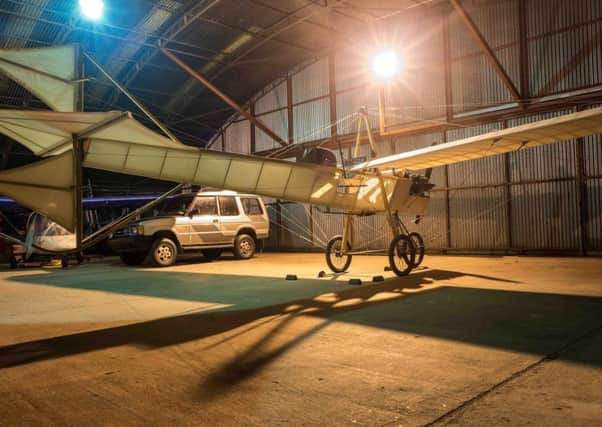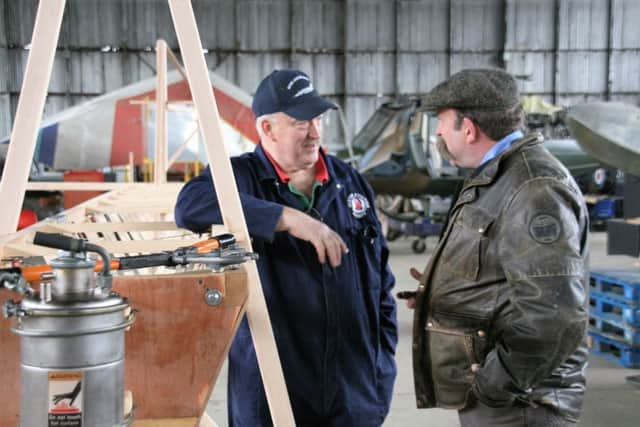Harry Ferguson's 1909 flying machine reinvented for 21st century


Best known for his innovations in agricultural machinery and for the tractor company that still bears his name, it is one of the engineering genius’s other great passions, aviation, that will be brought to the fore in the new BBC series.
In addition to his later achievements in the development of modern farming equipment, his fierce intellect and sky high ambitions had already led him to become the first Briton to achieve a sustained, powered flight in a plane he had designed and built himself.
Advertisement
Hide AdAdvertisement
Hide AdThe forthcoming documentary series, set to begin on Monday, follows the exploits of a team of modern aviation enthusiasts as they attempt to build an exact replica of the plane used by Ferguson.


The series will be presented by Dick Strawbridge, the Ballyclare High School-educated Royal Corps of Signals engineer who rose to prominence in the Channel Four series Scrapheap Challenge.
The News Letter spoke to one of those involved in the painstaking recreation, Owen Anderson, who is a pilot and instructor at the Ulster Gliding Club in Co Londonderry.
Owen explained that after Ferguson achieved his first successful flight, made in Co Down in 1909, he chose Magilligan as the location for further test flights because of the seven miles of unusually flat, sandy beaches between Benone and Downhill.
Advertisement
Hide AdAdvertisement
Hide Ad“The conditions down here in Magilligan are ideal,” he said.


“The beach is incredibly long and it is extremely flat, which makes it perfect. That is one of the main reasons the Ulster Gliding Club are based here ourselves. The conditions would have been ideal for Harry Ferguson.”
Owen has spent countless hours meticulously applying a historically appropriate linen covering to the skeletal wooden frame of the Harry Ferguson Mark Six replica.
A skilled pilot himself, he was reluctant to reveal whether the aircraft he had worked so hard to help recreate was actually up to the task of successful powered flight.
Advertisement
Hide AdAdvertisement
Hide Ad“You’ll have to wait and see,” he joked. “It was a painstaking labour but it was a labour of love.
“It was a really interesting project for me, personally, and it was a great honour for all of us here at the Ulster Gliding Club to be involved with it.
“The plane Harry Ferguson brought with him to Magilligan was a two-seater and the story is that he actually took a passenger up with him, a famous actress I believe, and he flew from Magilligan up to the Myroe junction.
“We use a modern engine that a lot of micro-lights would use – it is a much more reliable engine than the one from 1909 that Ferguson would have used.
Advertisement
Hide AdAdvertisement
Hide Ad“The airplane we have built is a one-seater and we have also added some safety instruments that wouldn’t have been available at that time, purely for safety reasons.
“The designs were given to a boat builder in east Belfast and the plane was taken down here to the Ulster Gliding Club where it was covered with a traditional type of linen. It was all done the way Harry Ferguson would have done it.
“There is no formal training for working with Irish linen or any type of fabric like that. There are probably only a few people left now in Ireland that are still able to do it.
“I’ve always known about Harry Ferguson down over the years, not just because of my interest in aviation, but also because of my grandfather Thomas Anderson, who lived down there at Magilligan.
Advertisement
Hide AdAdvertisement
Hide Ad“Legend has it that him and a few others had helped Harry Ferguson after he had crashed into the tide so I was well aware of the man himself and his legacy over the years.
“In some of the aspects of the airplane, he was well ahead of his time. For instance he used wing warping to turn the aircraft and he ran the wing controls down through the central axles of the wheels.
“It was an ingenious idea. He was a brilliant designer. I know he invented the three-point linkage so he had an excellent engineering brain.
“Speaking to Dick Strawbridge about it, who was a Royal Signals engineer, you really get a sense of Ferguson’s genius. He also had to pilot the thing himself.”
• The Great Flying Challenge is on BBC1 NI on Monday at 7.30pm.